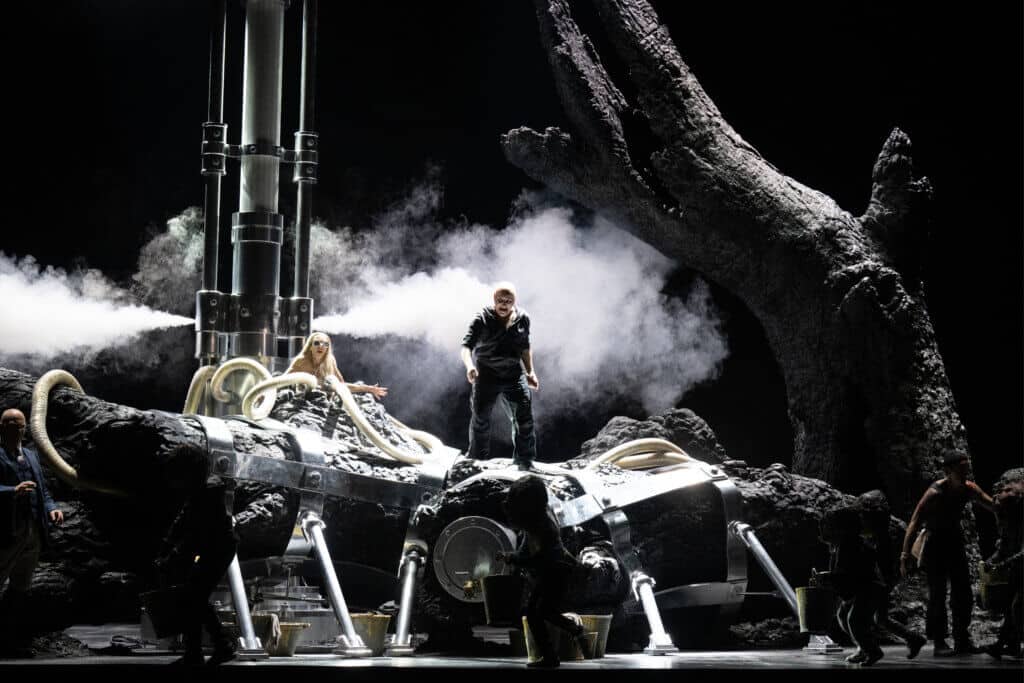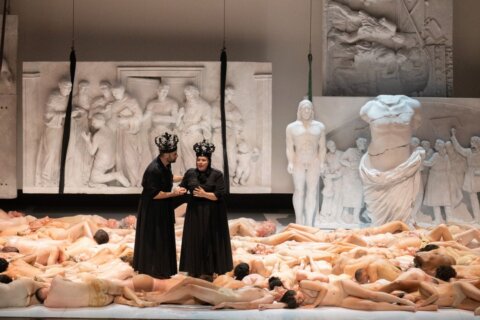DAS RHEINGOLD • ROYAL OPERA HOUSE LONDON
★★★★★☆

Photo: Monika Rittershaus
REVIEW DAS RHEINGOLD: MASTERFUL KICKOFF TO BARRIE KOSKY’S LONDON RING
A saturated silence spreads through London’s gala-clad, packed Royal Opera House as a stark naked 82-year-old woman with an almost intimidating, bony and emaciated body, strolls slowly across the stage with long, white, ancient hair and her face buried in her hands as if to say: What have we done? How did it get this far? This is how Barrie Kosky kicks off The Rhine Gold and his eagerly awaited London Ring, which, with its spectacular and gifted take on Wagner’s masterpiece, promises to be another notable success for the esteemed star director.
Behind the woman, who turns out to be the Earth Goddess Erda, the fallen, charred trunks of the ash tree that holds the world together in Wagner’s mythology are revealed. A sinister flash forward and a devilish omen of the doom that the Ring’s intricate storylines will soon set in motion.
Only now does the iconic 136-bar fluctuating E-flat major overture begin, summoning the Rhine daughters from within the tree so that the fatal encounter with the dwarf Alberich can take place. An interior that turns out to throb with a pulse of liquid gold.
The orchestra, conducted by the highly respected Antonio Pappano, plays at the highest technical level, albeit with a slightly more distinct sound and attitude than I experience in German opera houses, such as Bayreuth, where Wagner’s diligent use of soft horns takes on a particularly flattering, organic expression. Let’s call it a matter of taste.
The Rhine daughters are dressed in sexy black lingerie, and of course Alberich can’t resist their tantalizing flirtation, first stripping him naked, then immediately dressing him in lingerie and pulling his cock out so that it dangles ridiculously out of the lingerie in plain sight. (You read that right.)
Thus humiliated, Albericht has no problem renouncing love forever and gaining access to the Ring and its all-powerful power. The drama is on.
Kosky is the Steven Spielberg of opera and excels at drawing clear archetypes with recognizable human characteristics, good and bad.
Kosky says in an interview that his goal is to make us forget we’re at the opera and focus on the themes and human interactions. Maybe even learn a little more about ourselves.
On the surface, Kosky’s stage design constantly impresses with spectacular tableaux and dynamic flow. It’s virtually impossible to get bored at a Kosky staging.
This is where he differs from many of his colleagues, who often seem more willing to let a necessary artistic idea overshadow the entertainment value.
Alberich’s gold mine with the enslaved Niebelungs is a wild association with an astonishing scenic impact.
The charred trunks of ash wood now appear strung up in a kind of hi-tech industrial construction, with the goddess Erda strapped in with giant hoses attached to her breasts, while a huge stainless steel milking machine with flashing lights throbs eerily in the smoky background.
Together with the sound of the Niebelungs’ knocking and pecking in the underground, it creates a visual manifestation that is both alluring and repulsive at the same time, framing our rapacious exploitation of the earth’s resources.
A scary image so effective that it would make any Greenpeace fundraiser envious. It’s scary as hell, plain and simple.
This setup also includes the sequence where Wotan and Loki steal the Ring from Alberich after tricking the fool into turning himself into a frog, trapping him in a bag and then cutting off his ring finger so that blood flows. No wonder a bitter Alberich on this occasion invokes the curse on the Ring that will have such fatal consequences.
The three gentlemen are convincingly portrayed in that order by Christopher Maltman, Sean Panikkar and Christopher Purves in an ensemble cast with no weak links.
Soon after, giants Fasholt and Fafner arrive to settle the construction of Wotan’s prestigious Valhalla.
Of course, you already know that the giants have taken Wotan’s sister-in-law as collateral and that a final price of enough gold to cover her completely is agreed upon.
In Kosky’s version, this scene becomes Tarantino-level bestiality as the sister-in-law is forced into a coffin-like tub of tin and then doused with buckets of liquid gold until she nearly drowns.
Now in possession of the cursed ring, one giant kills the other by beating him to death with a polo mallet. Yes, there’s action!
The final scene where Wotan celebrates the seemingly happy ending of the drama with his family takes place in the most incredible waterfall (fall of sin?) of slowly falling glitter confetti, which continues as if in an endless paradise of Techniclo
Here, the party is enjoying themselves in party dresses, ignoring Erda, who stands slightly back on stage, naked and despairing in a pale strip of light, as the only one who has understood that this is a beginning of the end – wrapped in gold and glitter.
A stiff-upper-lip, conservative British audience responds with a huge, deserved applause that seems somewhat measured compared to the acclaim I’m sure Kosky would have scored in Berlin, Salzburg or Bayreuth.
Subsequent installments will premiere in the coming seasons, with the full London Ring cycle scheduled for 2028.
With the tasteful new Piazza bar and restaurant on the London Opera’s rooftop, including sublime views of Covent Garden, it wouldn’t be a bad place to spend a short week’s vacation with what promises to be an opera production of the highest international class.




